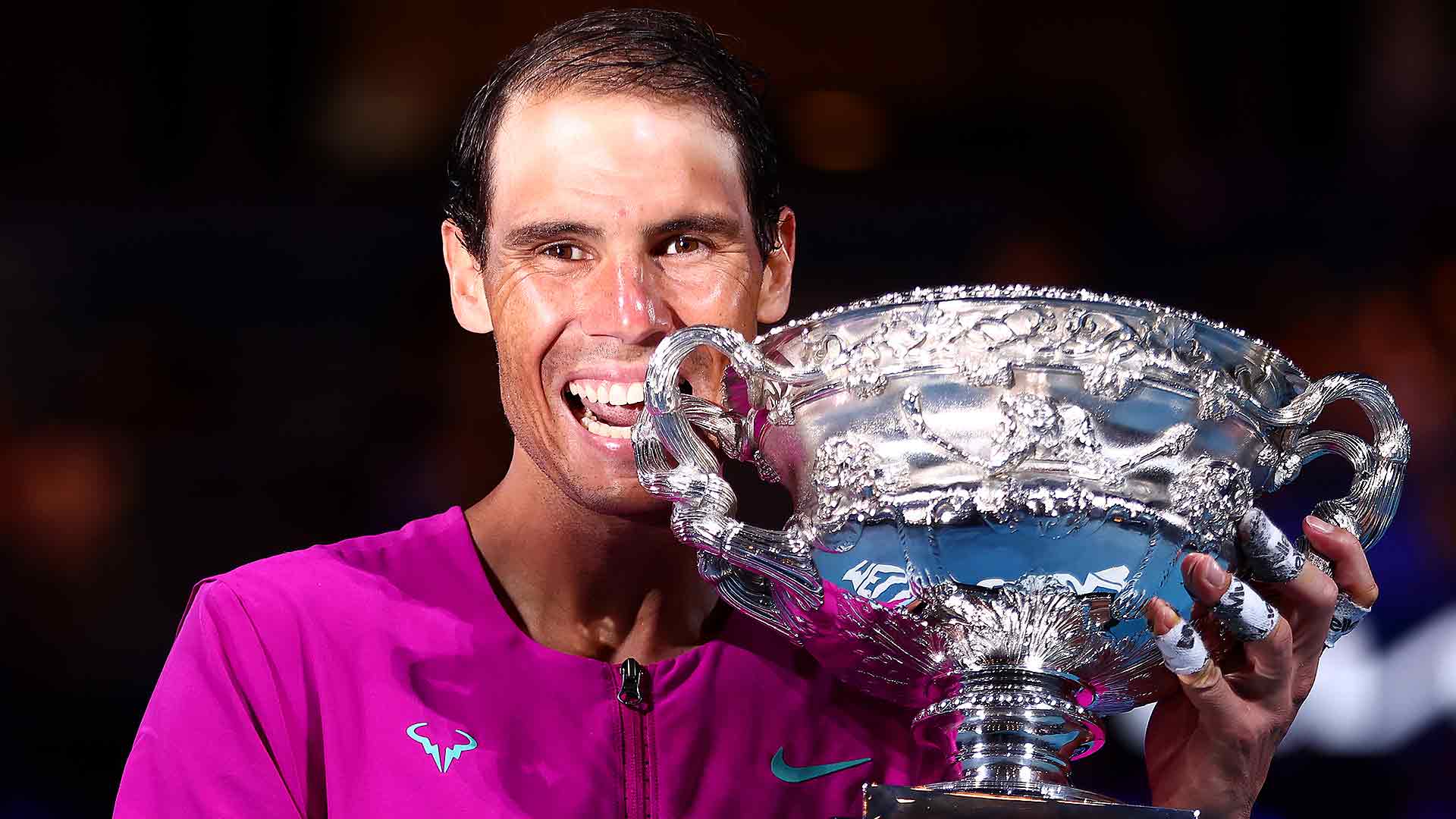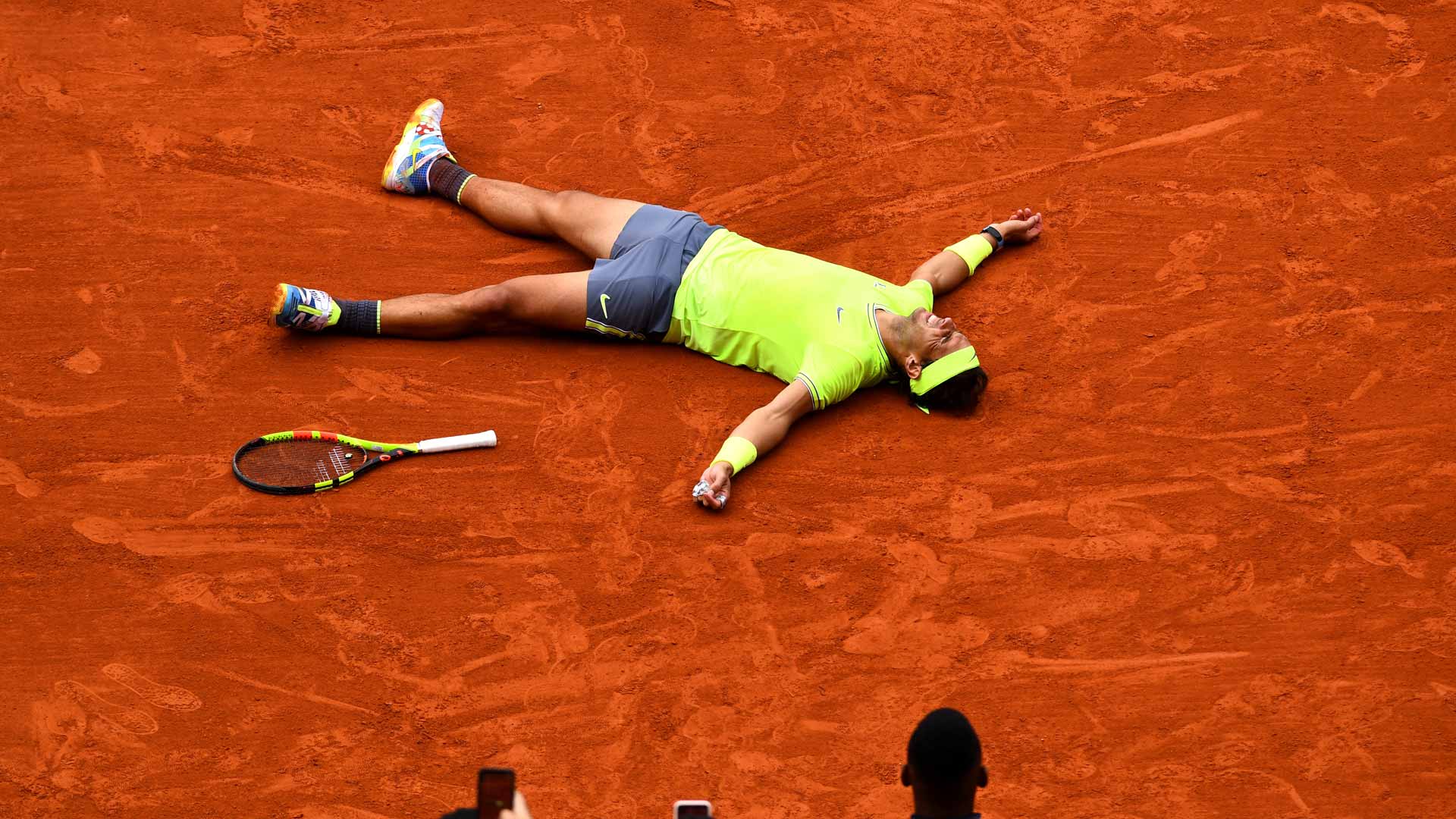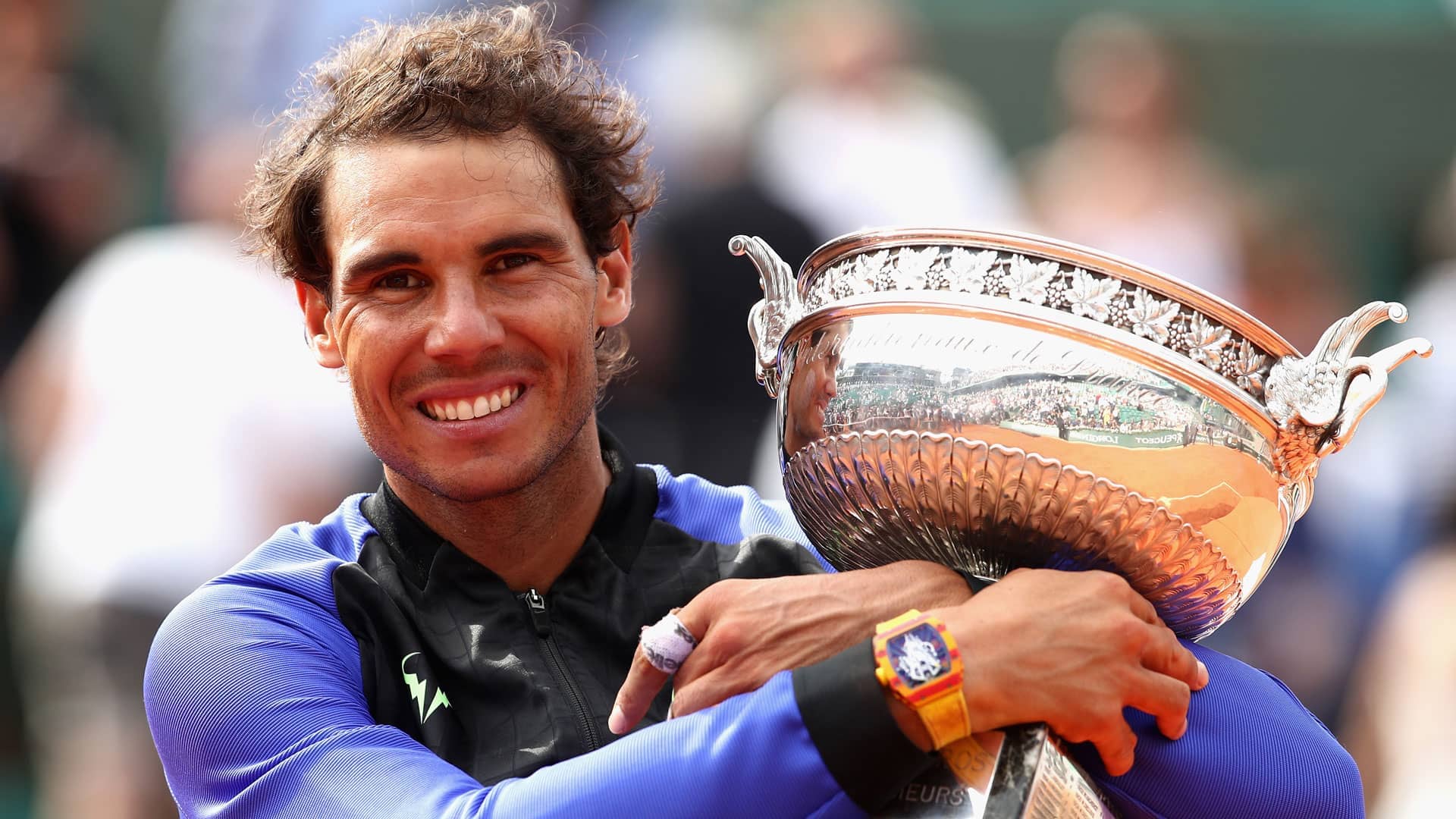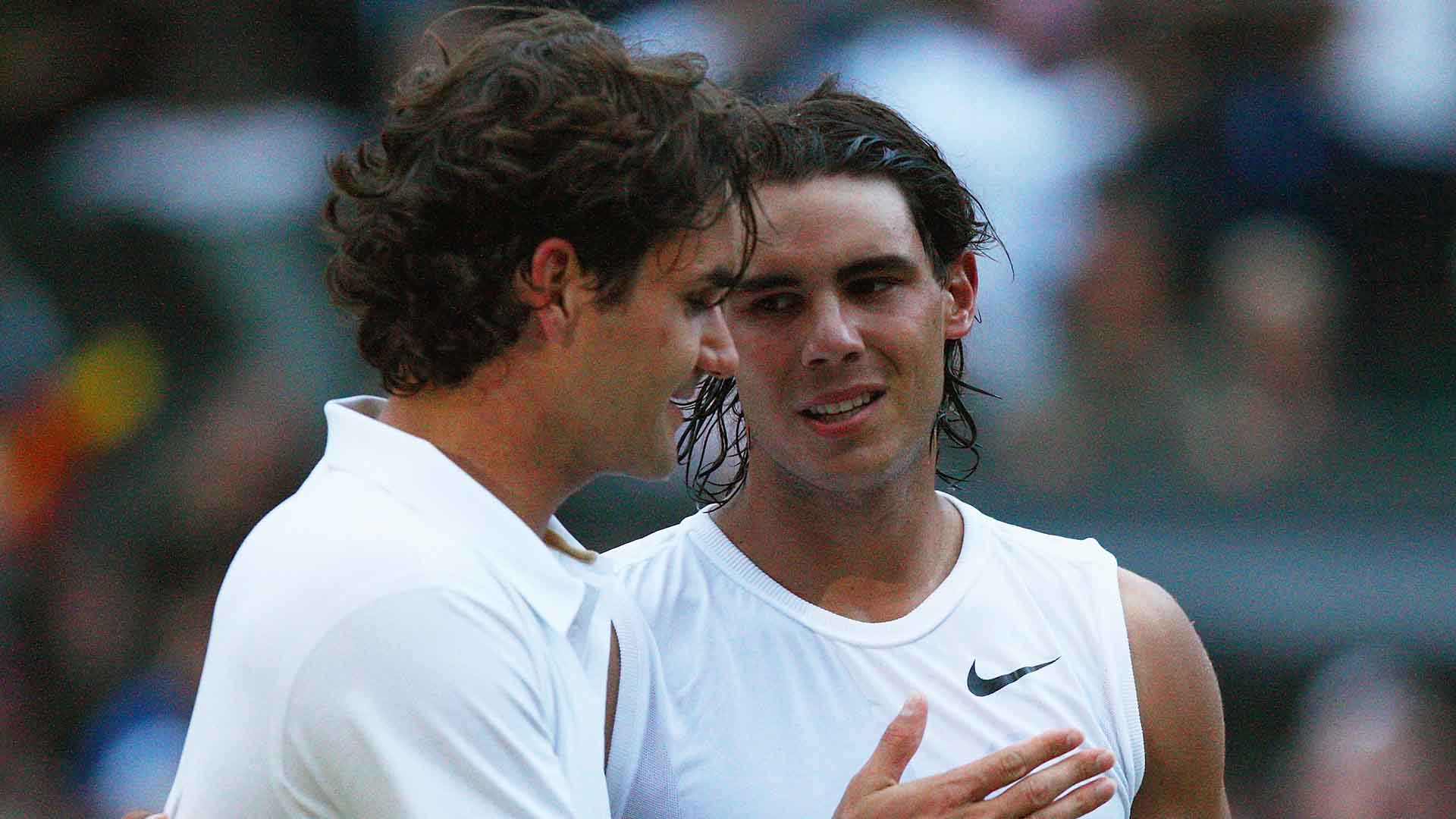Looking for Tennis and Racket Sports International News?
Rafael Nadal's Grand Slam Greatness
To celebrate the end of Rafael Nadal's historic career at this week's Davis Cup Final 8, ATPTour.com is publishing a series of articles paying tribute to the Spaniard. View our #RafaSiempre series.
When Rafael Nadal stepped onto Wimbledon's hallowed courts in 2003, a buzz surrounded the young Spaniard, hinting at his potential to dominate on the grandest stages.
At just 17, Nadal, though slight in stature with his Nike shirt draping loosely, showcased tenacity that belied his age. He battled past former World No. 7 Mario Ancic in four sets, marking his debut main-draw victory at a major. Nadal's journey to the third round at SW19 in 2003 made him the youngest man since Boris Becker in 1984 to reach the last 32 at Wimbledon.
Leaving London that summer, Nadal carried with him heightened expectations, but hard work lay ahead. Little did anyone suspect the monumental Grand Slam career that would follow.
With 314 Grand Slam match wins and an astounding 22 major titles to his name, ATPTour.com revisits Nadal’s pivotal moments across all four majors, tracing his journey from promising newcomer to history maker.
[ATP APP]Australian Open – Champion 2009, 2022; Win/Loss 77-16
Nadal had missed the second half of the 2021 season with a left foot injury and arrived in Australia with limited match time to his name. While he won an ATP 250 event in Melbourne in the lead up, expectations on the Spaniard were low heading into the 2022 Australian Open.
Fast forward two weeks and Nadal was the champion at the major for the second time, having produced one of the great major final comebacks. He battled back from two-sets-to-love down to defeat Daniil Medvedev, with the Spaniard’s 2-6, 6-7(5), 6-4, 6-4, 7-5 victory in five hours and 24 minutes moving him to 21 major crowns, a lead in the Grand Slam race at the time.
“Tonight has been very special,” Nadal said. “I give it everything that I have inside, believe me. I am super, super-tired in all ways. I even can’t celebrate. But was the day to give everything. I enjoyed. I enjoyed the fight. I enjoyed the emotions. At the end have this trophy with me means everything today.”

Photo Credit: Getty Images
Nadal’s victory against Medvedev is one that defines the lefty's career. The then-35-year-old looked down and out when he trailed 2-6, 6-7(5), 2-3, 0/40, but refused to surrender, straining every muscle to wrestle the title away from Medvedev. That night in Melbourne is Nadal’s greatest at the AO, but is closely followed by his title run at the event in 2009, when he clawed past Roger Federer in five sets to win his first Aussie Open trophy.
Federer would go on to gain revenge against Nadal in the 2017 final, one of four title matches the Spaniard lost in Melbourne. Nadal’s most notable championship-match heartbreak came in 2012 when he lost to Novak Djokovic in five sets. The clash lasted five hours and 53 minutes, overtaking the longest major final match record that was previously set by Mats Wilander and Ivan Lendl at the 1988 US Open.
Nadal, who fell to Stan Wawrinka in the 2014 final and Djokovic again in the 2019 title match, tallied a 77-16 record in Melbourne, where he advanced to the quarter-final stage or beyond in 14 of his 18 appearances. His first match win at the AO came in 2004 against Michael Tabara.
Roland Garros – Champion 2005, 2006, 2007, 2008, 2010, 2011, 2012, 2013, 2014, 2017, 2018, 2019, 2020, 2022; Win/Loss 112-4 Nadal's saga at Roland Garros is a tennis and sporting tale like no other. It is a story of grit, glory and an almost mythical dominance on the red clay in Paris. Since bursting onto the scene in 2005, Nadal transformed the Parisian tournament into his personal kingdom, amassing a staggering 14 titles. This record isn't merely a collection of victories; it's a chronicle of resilience, strategic brilliance, and unyielding passion.Nadal’s introduction to Roland Garros in 2005 was sensational. At just 19, he stormed through the tournament, his youthful exuberance matched by a tenacity that belied his age. He defeated then-World No. 1 Roger Federer in the semi-finals to earn his first clay-court victory against the Swiss before he overpowered Mariano Puerta in the final, signaling the dawn of a new era in tennis. His first title was the beginning of what would become an extraordinary love affair with Roland Garros.
From 2005 to 2008, Nadal crafted an era of dominance, clinching four consecutive titles in Paris at the expense of Federer. The Spaniard's final victories over his great rival in 2006, 2007 and 2008 were comprehensive, with the lefty dropping just four games against Federer in 2008. It was a performance that left the tennis world in awe and solidified his moniker: the 'King of Clay’.
“He plays like two forehands from the baseline because he has an open stance on both sides," said Federer after he suffered the heaviest Grand Slam defeat of his career at the time. "So he's got a huge advantage, and he's so tough mentally too."

Photo Credit: Getty Images
The year 2009 brought a rare twist in Nadal’s Roland Garros narrative. Against all odds, he was defeated by Swede Robin Soderling in the fourth round. It was the first time Nadal had lost on the terre battue of Roland Garros, with Soderling crushing the ball off both wings to earn a four-set victory. Nadal's cloak of invincibility at Roland Garros had been dragged off. For many, it was a shock, but for Nadal, it was a catalyst.
The following year, he returned with a vengeance, reclaiming his throne and starting another streak of dominance. His victory in 2010, when he beat Soderling in the final to gain revenge, began a five-year title run, during which he adapted his game to fend off emerging rivals and manage his own physical limitations. His 2012 four-set triumph over Djokovic was particularly poignant, breaking Bjorn Borg’s record with his seventh title.
Nadal faced new challenges in the mid-2010s as injuries and fierce competition tested his reign. Yet, in 2017, he made history again with "La Décima"—his 10th crown at the major. After crushing Stan Wawrinka in straight sets, the Spaniard produced his iconic celebration, dropping to the clay before rising and soaking in the applause of the Philippe Chatrier crowd.

Photo Credit: Getty Images
The story didn’t end there. Nadal continued to weave his magic on the clay, adding titles in 2018, 2019, and 2020. Each victory was a chapter in his epic, with the 2020 final against Djokovic standing out as a masterclass in clay-court tennis. Without dropping a set, Nadal showcased his enduring dominance by winning the trophy in October after Covid-19 had resulted in the suspension of the event in May.
In 2022, Nadal’s legacy was further etched into the annals of Roland Garros history with his 14th and final title at the major. Nadal dispatched Norway's Casper Ruud for the loss of just six games, reminding everyone once again why Roland Garros is often referred to as Nadal’s backyard.
Nadal finished his career holding a 112-4 record at the event. In all 14 finals, he was never taken to five sets, with Federer describing his record at the major as 'one of the greatest achievements in sport.'
Wimbledon – Champion 2008, 2010; Win/Loss 58-12 Just as he had done in 2006 and 2007, Nadal arrived at Wimbledon in 2008 off the back of a victory against Roger Federer on clay in the Roland Garros final. In the two years prior to 2008, the Spaniard had gone on to lose against his Swiss rival in the title match at SW19. However, the signs were in place that Nadal was closer to cracking Federer on the Wimbledon lawns, having lost in five sets in 2007.The culmination of Nadal’s efforts came in 2008. Entering the final, Nadal had dropped just one set across his six matches and he started fast in the championship match. The Spaniard moved into a two-set lead and looked set to break his Wimbledon duck before Federer fought back to level. With darkness falling in London, Nadal found an extra gear, dropping to his back after sealing victory in what many regard as the greatest match of all time.
Nadal’s four-hour, 48-minute victory, ending at 9:15 p.m. local time, ended Federer’s five-year winning streak at Wimbledon and marked Nadal’s first major title away from Roland Garros. It was the first time since Bjorn Borg in 1980 that a player had clinched the Roland Garros-Wimbledon double.
"[I'm] just very happy because I played with a very positive attitude all the time," said Nadal at the time. “[To] win here is unbelievable for me."

Photo Credit: Getty Images
Nadal’s second Wimbledon title came in 2010, when he defeated Tomas Berdych in the final with a commanding performance, showcasing his adaptability and tactical intelligence. His ability to adjust his game for grass courts—emphasising flatter groundstrokes and more aggressive net play — had been consolidated by his 2010 triumph.
The Spaniard faced more challenges at Wimbledon than any other major, though. He suffered shock early defeats to Lukas Rosol (2012), Steve Darcis (2013) and Dustin Brown (2015), while he lost before the quarter-final stage in seven of his 15 appearances. He enjoyed semi-final runs on the London lawns in 2018, 2019 and 2022. In 2018, he faced Djokovic in a mammoth semi-final that spanned two days, ultimately losing in five sets. In 2019 he suffered another defeat to Federer in the pair’s first meeting at the tournament since 2008.
US Open – Champion 2010, 2013, 2017, 2019; Win/Loss 67-12
Nadal made his debut at the US Open in 2003, stepping onto the courts of New York as a 17-year-old with immense promise. Though his first appearance ended in a second-round exit, it was clear that Nadal had the potential to become a force on hard courts. His aggressive baseline play and never-say-die attitude resonated with the New York crowd, which would come to cherish his tenacity and passion.
The real breakthrough for Nadal in 'The Big Apple' came in 2010. Already a winner of multiple majors on clay and grass, he arrived in New York determined to conquer the hard courts of Flushing Meadows. That year, he added a revamped serve to his game, making him more formidable as he clinched Slams at Roland Garros and Wimbledon. In New York, Nadal did not lose a set en route to the final and he capped it off with a four-set victory over Djokovic, securing his first US Open title and completing the career Grand Slam.
“I’m still 24. For me, it's a dream to have the career Grand Slam, but this is more a dream to have the US Open,” Nadal said. “[It’s an] unbelievable feeling because I worked a lot all my life, in all difficult moments to be here, but I never imagined to have the four Grand Slams.”

Photo Credit: Getty Images
Nadal's relationship with the US Open was mixed. In 2011, he reached the final again but was outplayed by Djokovic in a high-quality four-set match. The following year, injuries forced him to miss the tournament, a stark reminder of the physical demands of his relentless style of play. These setbacks, however, only fuelled Nadal's determination to return stronger.
The 2013 season was a year of resurgence for Nadal. After a period plagued by knee issues, he came back with renewed vigour. His path to the title saw him defeat Djokovic in another memorable final, acting as the catalyst for his return to No. 1 in the PIF ATP Rankings that October.
After losing in the third round in 2015 and the fourth round in 2016, Nadal would go on to win the title again in 2017, when he defeated South African Kevin Anderson in the title match. Perhaps the most dramatic chapter in Nadal’s US Open saga came in 2019 and the man on the other side of the net was Daniil Medvedev, the opponent the Spaniard would go on to down in Melbourne two and a half years later. In a gripping five-set final, Nadal showcased everything that makes him a legend: endurance, tactical prowess, and an indomitable spirit. After nearly five hours of battle, Nadal emerged victorious, collapsing in tears of joy and exhaustion.
A four-time champion in New York, Nadal has the joint-second-most titles, alongside John McEnroe, at Flushing Meadows in the Open Era. Only Pete Sampras, Jimmy Connors and Federer (five) have bettered him.
[NEWSLETTER FORM]
When you subscribe to the blog, we will send you an e-mail when there are new updates on the site so you wouldn't miss them.

